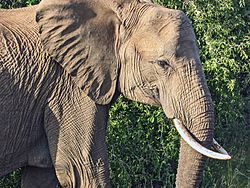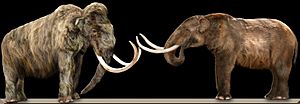Proboscidea facts for kids
Quick facts for kids ProboscideaTemporal range: late Palaeocene – Recent
|
|
|---|---|
 |
|
| African elephant | |
| Scientific classification | |
| Kingdom: | |
| Phylum: | |
| Class: | |
| Infraclass: | |
| Superorder: | |
| Order: |
Proboscidea
Illiger, 1811
|
Proboscidea is a special group of animals, also known as an order, that includes all elephants. Today, there is only one family of living animals in this group: the Elephantidae. This family has three amazing species of elephants: the African forest elephant, the African bush elephant, and the Asian elephant.
Millions of years ago, especially during the last ice age, there were many more types of proboscideans. These included giant, elephant-like creatures such as the mammoths and mastodons, which are now extinct.
The very first proboscideans lived over 50 million years ago, during the early Palaeogene period. Over time, these animals changed a lot. Their heads and jaws evolved, and their tusks and molar teeth took on different shapes.
Contents
What are Proboscideans?
Proboscideans are a group of large mammals known for their long, flexible trunks. This trunk is called a "proboscis," which is where the group gets its name. Besides their trunks, they are also famous for their large size and often, their impressive tusks.
Living Proboscideans: Elephants
Today, elephants are the only living members of the Proboscidea order. They are the largest land animals on Earth. Elephants are known for being very intelligent and having strong family bonds. They live in different parts of Africa and Asia.
- African bush elephants are the largest land animals. They live in savannas and forests across Africa.
- African forest elephants are smaller and live in the dense forests of Central and West Africa.
- Asian elephants are found in various habitats across Asia. They are slightly smaller than African elephants.
Ancient Proboscideans: Mammoths and Mastodons
Long ago, the Proboscidea order was much more diverse. Many different families and species lived all over the world. These ancient relatives of elephants were often huge and had unique features.
- Mammoths were large, hairy elephants that lived during the Ice Age. The Woolly mammoth is the most famous type. They had long, curved tusks and thick fur to survive in cold climates.
- Mastodons were another group of extinct proboscideans. They looked similar to mammoths but had different teeth. Mastodons had cone-shaped teeth, which helped them eat leaves and branches.
Families of Proboscideans
The elephants we see today are the only survivors of a once much larger and more varied group of animals. Many other families of proboscideans have gone extinct over millions of years. Here are some of the main families that once roamed the Earth:
- Elephantidae: This is the family that includes all modern elephants.
- †Gomphotheriidae: These were a diverse group with four tusks, two in the upper jaw and two in the lower.
- †Mammutidae: This family includes the famous mastodons.
- †Stegodontidae: These were large, elephant-like animals with long, straight tusks.
- †Barytheriidae: These were early proboscideans from Africa, known for their short, stout tusks.
- †Deinotheriidae: This group had unique downward-curving tusks in their lower jaw.
- †Moeritheriidae: These were some of the earliest and smallest proboscideans, living in water.
- †Numidotheriidae: Another early family of proboscideans from Africa.
- †Phiomiidae: Small, pig-like proboscideans that lived in ancient Egypt.
See also
 In Spanish: Proboscídeos para niños
In Spanish: Proboscídeos para niños


